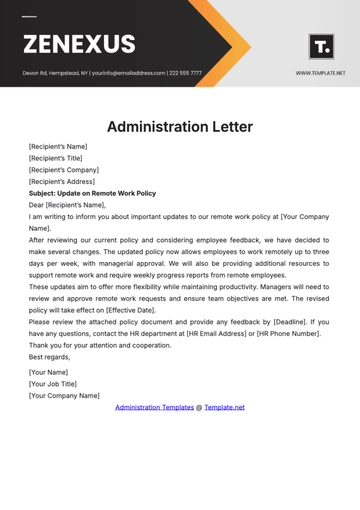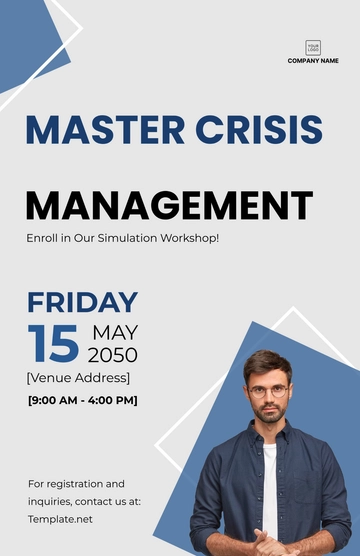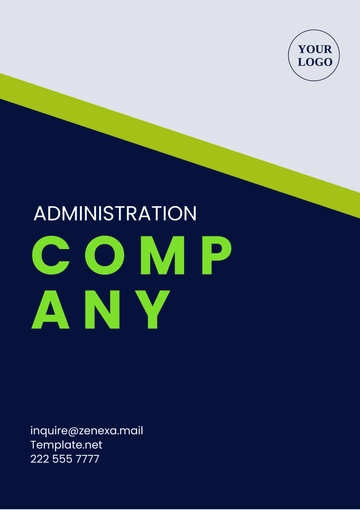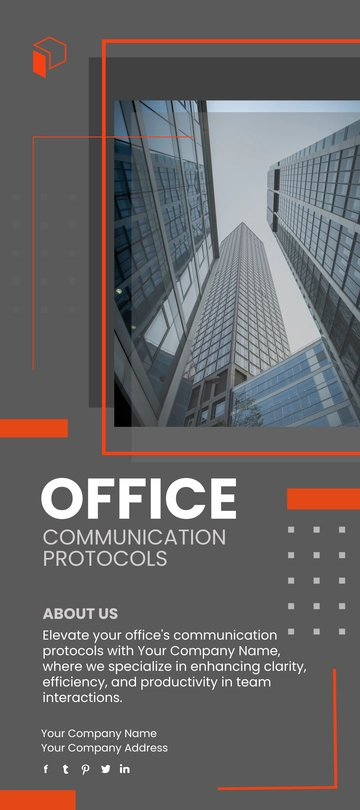Free Administration Management Document

I. Introduction
[Your Company Name] specializes in delivering comprehensive administrative services to businesses of all sizes. This document outlines the core components of Administration Management, which are essential for maintaining efficient operations, ensuring compliance, and enhancing organizational effectiveness. Administration Management at [Your Company Name] focuses on optimizing office processes, managing resources, and supporting overall business goals.
II. Core Responsibilities
Administration Management encompasses various responsibilities that are critical to the successful operation of the company. These include:
A. Office Management
Facilities Maintenance: Ensuring that the physical office environment is well-maintained, clean, and safe for all employees.
Supplies Management: Overseeing the procurement and inventory of office supplies to prevent shortages and ensure operational continuity.
Workspace Allocation: Managing the assignment and utilization of workspaces to maximize efficiency and comfort for employees.
Vendor Management: Establishing and maintaining relationships with vendors for office services such as cleaning, catering, and equipment maintenance.
B. Human Resources Support
Employee Onboarding: Facilitating the integration of new employees into the company by managing orientation sessions, preparing workspaces, and ensuring they have the necessary tools and resources.
Payroll Administration: Coordinating with HR to ensure accurate and timely payroll processing, including handling employee queries related to compensation.
Records Management: Maintaining and securing employee records, ensuring compliance with data protection regulations.
Training Coordination: Supporting HR in organizing and managing employee training programs to foster skill development and growth.
C. Communication and Correspondence
Internal Communication: Managing internal communication channels to ensure timely and effective dissemination of information across the company.
External Correspondence: Handling all official correspondence with clients, vendors, and other stakeholders, ensuring professionalism and accuracy.
Document Management: Ensuring proper documentation and archiving of all business communications, both internal and external.
Meeting Coordination: Organizing meetings, preparing agendas, and ensuring that all necessary materials are available for productive discussions.
D. Information Technology Support
IT Infrastructure Management: Overseeing the maintenance and upgrade of IT systems, ensuring they meet the company's needs and are secure from threats.
Technical Support: Providing first-line support for IT issues faced by employees, coordinating with the IT department or external vendors for resolution.
Data Security: Implementing policies and practices to safeguard company data from unauthorized access, breaches, and other security threats.
Software Management: Managing software licenses and ensuring that all employees have access to the tools they need for their work.
III. Administrative Processes
Efficient administration is supported by well-defined processes that ensure tasks are completed accurately and on time. Key processes include:
A. Document Management
Document Creation: Establishing standardized templates for commonly used documents to ensure consistency and professionalism.
Document Storage: Implementing an organized filing system, both digital and physical, for easy retrieval and secure storage of documents.
Document Retention: Adhering to legal and regulatory requirements for document retention and disposal, ensuring compliance and reducing risk.
Document Sharing: Facilitating secure sharing of documents within the company and with external stakeholders while protecting sensitive information.
B. Workflow Optimization
Process Mapping: Analyzing and documenting existing workflows to identify bottlenecks and inefficiencies.
Automation: Implementing software tools to automate repetitive tasks, reducing manual effort, and improving accuracy.
Continuous Improvement: Regularly reviewing and updating processes to ensure they remain effective and aligned with business goals.
Performance Monitoring: Setting up key performance indicators (KPIs) to measure the efficiency and effectiveness of administrative processes.
C. Compliance Management
Regulatory Compliance: Ensuring that all administrative practices comply with relevant laws and regulations, such as labor laws, data protection regulations, and health and safety standards.
Audit Preparation: Coordinating with external auditors to prepare for audits, ensuring that all required documentation and processes are in place.
Risk Management: Identifying potential risks in administrative processes and implementing controls to mitigate them.
Policy Implementation: Developing and enforcing company policies related to administration, such as data protection, workplace safety, and resource usage.
IV. Resource Allocation
Effective administration requires careful allocation of resources, ensuring that the company’s assets are used efficiently and support business operations.
A. Budgeting
Budgeting is a fundamental aspect of administration management that ensures the financial resources of [Your Company Name] are allocated efficiently and aligned with the company’s strategic goals. Effective budgeting allows the company to plan for future expenditures, manage cash flow, and ensure financial stability.
Department | Annual Budget | Q1 | Q2 | Q3 | Q4 |
|---|---|---|---|---|---|
Human Resources | $200,000 | $50,000 | $50,000 | $50,000 | $50,000 |
Marketing | $300,000 | $75,000 | $75,000 | $75,000 | $75,000 |
Operations | $500,000 | $125,000 | $125,000 | $125,000 | $125,000 |
IT | $150,000 | $37,500 | $37,500 | $37,500 | $37,500 |
Training & Development | $100,000 | $25,000 | $25,000 | $25,000 | $25,000 |
This table provides a breakdown of the annual budget allocated to each department within [Your Company Name]. It illustrates the distribution of financial resources across quarters, allowing for effective planning and management of funds throughout the year.
B. Resource Management
Asset Management: Keeping track of the company’s physical assets, such as office furniture, equipment, and IT infrastructure, to ensure proper usage and maintenance.
Procurement: Overseeing the procurement of goods and services, ensuring that purchases are made at the best possible price and meet the company’s quality standards.
Inventory Control: Maintaining optimal levels of inventory for office supplies and equipment, ensuring availability while avoiding excess stock.
Vendor Relations: Managing relationships with suppliers and service providers to ensure timely delivery of goods and services and favorable terms.
V. Training and Development
Training programs are vital for enhancing the skills and competencies of employees at [Your Company Name]. By investing in continuous learning and development, the company ensures that its workforce remains competent, competitive, and capable of meeting the challenges of the industry.
A. Training Programs
Training programs are structured learning experiences designed to improve employee skills, knowledge, and performance. These programs may include workshops, seminars, online courses, and hands-on training sessions. The aim is to develop both technical and soft skills that are essential for employees to perform their roles effectively and contribute to the company's success.
Training Program | Target Employees | Schedule | Cost |
|---|---|---|---|
Leadership Development | Mid-Level Managers | [Month Day, Year] | $30,000 |
Customer Service Excellence | Customer Support Team | [Month Day, Year] | $15,000 |
IT Security Training | All Employees | [Month Day, Year] | $10,000 |
Project Management | Project Managers | [Month Day, Year] | $20,000 |
Compliance and Ethics | Entire Staff | [Month Day, Year] | $12,000 |
This table outlines the schedule of training programs for the year. Each program is tailored to specific employee groups, ensuring that all staff members receive relevant and beneficial training. The costs associated with these programs are also indicated to facilitate budgeting and resource allocation.
B. Performance Evaluation
Performance evaluation is a critical process for assessing the effectiveness and efficiency of employees at [Your Company Name]. Regular evaluation ensures that employees meet the organization’s standards and objectives, and it provides opportunities for feedback and development.
Criteria | Weight | Description |
|---|---|---|
Quality of Work | 30% | Assessment of the accuracy, thoroughness, and effectiveness of work output. |
Timeliness | 20% | Evaluation of the ability to meet deadlines and manage time effectively. |
Teamwork | 20% | Assessment of collaboration and contribution to team goals. |
Communication Skills | 15% | Evaluation of verbal and written communication abilities. |
Innovation and Problem-Solving | 15% | Assessment of creativity and ability to develop solutions to challenges. |
This table outlines the key criteria used in the performance evaluation process. Each criterion is weighted to reflect its importance in the overall assessment. By evaluating these aspects, [Your Company Name] can ensure that employees are contributing effectively to the organization’s goals.
VI. Next Steps
To ensure the effective implementation of the administration management strategies outlined in this document, [Your Company Name] will take the following next steps:
Review and Finalize Budgets: Conduct a detailed review of the proposed budget allocations for each department. Ensure that all financial resources are aligned with the strategic goals of the company. Finalize the budget by obtaining approval from senior management.
Implement Performance Evaluation Tools: Deploy the necessary tools and systems for conducting performance evaluations. Train managers and HR personnel on the use of these tools, ensuring that the evaluation process is consistent, fair, and aligned with the company’s standards.
Monitor and Adjust as Needed: Establish a system for continuous monitoring of the administration management processes. Regularly review the effectiveness of budgeting, training programs, and performance evaluations, making adjustments as necessary to improve outcomes.
Feedback and Continuous Improvement: Gather feedback from employees and managers on the administration management processes. Use this feedback to make improvements and ensure that the processes remain relevant and effective in meeting the company’s evolving needs.
By implementing the processes and practices outlined in this document, the company ensures efficient operations, compliance with regulations, and a productive work environment. Continuous evaluation and improvement of administrative processes are essential for maintaining the high standards required to achieve business objectives.
- 100% Customizable, free editor
- Access 1 Million+ Templates, photo’s & graphics
- Download or share as a template
- Click and replace photos, graphics, text, backgrounds
- Resize, crop, AI write & more
- Access advanced editor
Streamline your administrative tasks with our Administration Management Document Template from Template.net. Fully customizable and editable, this template features a professional and organized layout ideal for managing administrative processes, policies, and records. Effortlessly personalize the document, editable in our Ai Editor Tool, to suit your organization’s needs and branding.





























